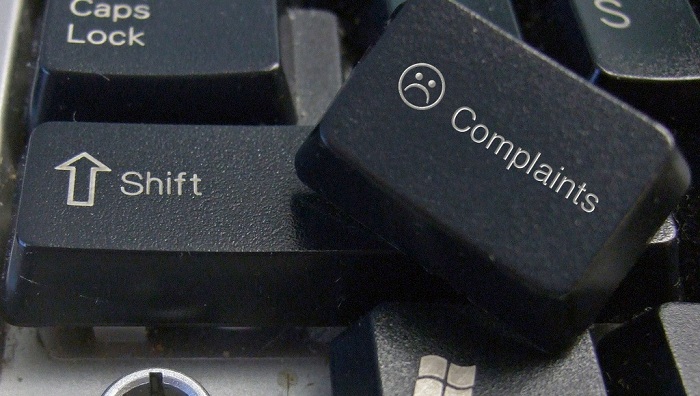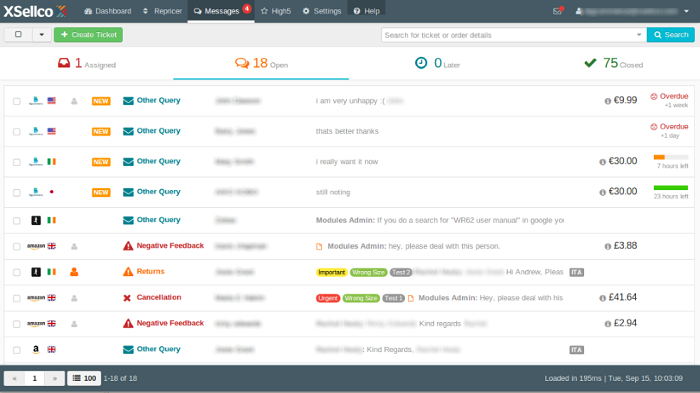In Part 1 of this post, we looked at how you can adapt your business to attract customers and encourage loyalty using high quality listings and quality data to justify higher prices, removing you from ‘the race to the bottom’.
Your relationship with the customer starts right from the listings and the product, through processing and dispatch of the item, how well the items are packaged, the courier you choose. Somebody will complain however – Someone ALWAYS complains.
What do we do when things go wrong?
Complaints are the point where you must find a way to smile and be positive, no matter what people say – Even if you KNOW that the problem lies with them. Good customer service does not mean that you give the customer what they want, or free goods if it has a mark or is the wrong colour.
It’s about making sure you answer their questions quickly, politely, and deal with their issues well. It’s about owning up to mistakes, handling them quickly and professionally, and making sure the customer gets what they paid for. It’s about not taking it personally, because generally speaking it isn’t personal or malicious, so don’t let the bad apples sour your approach.
For a start, no matter who is dealing with the customers, be it you, or your staff, you should be well motivated, positive and patient, and are therefore able to take the time to deal with their issues and research things properly. Rushing CS or treating the customer poorly will be a quick way to poor feedback, whatever the outcome. Try establishing some basic procedures for initial responses and more than anything else, it’s about offering tangible reasons to want to buy from you other than Price. If you are charging 10% more than your competitor, but selling more, because people would rather buy from you knowing you will look after them – Then you’re doing it right!
Today, 66% of customers would change providers for products or services if they were getting bad customer service. In 2005, only 17% of people would say the same. That’s a big change, and shows that it’s not JUST about the bottom line anymore. People are learning to balance their expenditure with the quality of the experience. They want to be valued by the companies they work with, and to value them in turn.
So answer promptly – And consistently. Read the question first, and ensure you understand the problem. Ensure that you have thought ahead, categorise potential complaints now and what the response should involve. A good technique is to restate their issue in your own words to show you understand, or avoid misunderstandings early.
If the item didn’t arrive, then look at the service they used. Is it tracked? Great, check the tracking history and see what happened to it.
If the item arrived damaged, then firstly – Why did the customer sign for it and accept responsibility? You need pictorial evidence from them to show what the issue was and confirm it’s your responsibility, or the courier’s. And you need to make sure the broken product is the same one you sent – This is especially common for seller’s who sell replacement parts for equipment, or consumables.
If the item was incorrect, then check the order – What did they order? Is the item they received correct and they have changed their mind? Does the picture show the SAME item?
All this and more needs to be part of your process. Because there’s a difference between being helpful, giving good customer service, and throwing money into the postbox. By all means, swap unopened items, for a restocking fee, or postage, to cover your costs. Learn the law about returns and refunds not only where you are based, but also where people are buying your products… German laws and English laws are slightly different, for example.
Beyond the chat window and the Email inbox
Customer Service isn’t just talking to the customer when there’s a question or an issue, though – It’s part of the whole process from researching a product, all the way to payment, delivery and “What if?” – What if there is a problem?
You can use the data you are gathering in your tools to help here. How are you handling your communications with the customer? Manually in outlook? How are you tracking your orders? More information is better in the modern age, as long as you can use it. Consider a tool like XSellCo Fusion – Unifying your communications with the customer, and being able to integrate your order records will simplify the task of communication with your customer, and make it easier to review your data for trends, and to improve the standard of answers and the need for them.
Look back at your complaints about different products, or delivery services – Are you consistently getting the same problems? Maybe it’s time to start spot checking, or even sending out some test orders to some people you know. You might even want to try upgrading the courier for a couple of customers that have had lots of issues.
If some of your products aren’t of high enough quality, talk to your supplier, and get your complaints and returns down to improve your bottom line – maybe even get a credit for your troubles! You and your customers deserve better.
If deliveries aren’t being handled properly by one of your couriers, then firstly – Talk to them. It could be 1 or 2 bad apples, and they may give you compensation to keep your account. If it’s not an isolated issue, though, look at your options to move to someone with higher standards within your price range. Consider looking at some of the Logistics companies that offer multiple companies’ services to give you the range you need.
Are the issues you get after delivery down to miscommunication? If so, then why not revise the information for that items and answer the question so they don’t need to ask. Look at how people are using your website (Have you seen Zarget?) and see if you can improve the way the website works to make it easier for people to find the right products and buy them. This is good customer service, no one WANTS to ask questions or complain unless they have to – They want to have a nice, easy journey through your site to the checkout.
Look at Lost Baskets, too. If people are leaving at the last hurdle without even talking to you, find out why. Buy from yourself a few times and look for issues – Are you missing a major payment option, are buttons hard to find or read? Make sure the customer’s experience and journey are as close to friction less as possible and they will be happy. And when they talk to you, they’ll be relaxed, rather than stressed – Making life easier for you and your staff!
Conclusion
As you can see, we tend to think that Customer Service begins, and ends at the mailbox, and we have been conditioned to believe that it mostly involves refunding people and waiting for returns. In reality, though, it’s an organic part of your business, and tied into managing the customer journey to minimise, or eliminate, mistaken orders, broken products and other damages. At that point, the customers will not NEED to contact or complain to you, and everyone is much happier. Won’t that be much better? If your customers call you up to complement your products and service?



